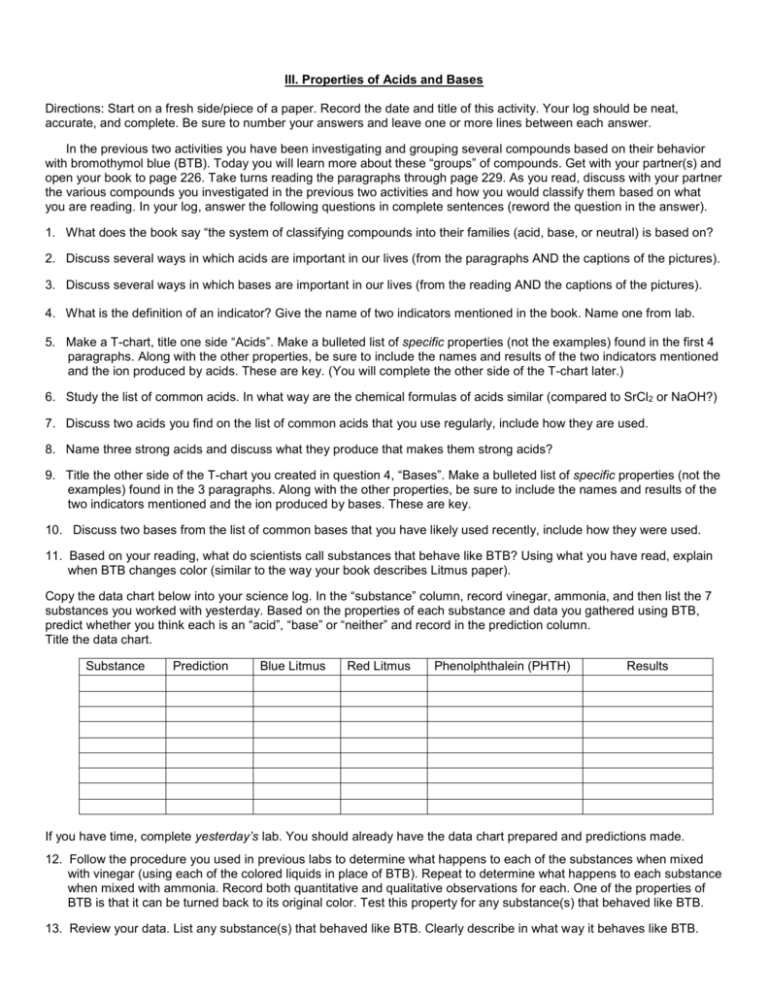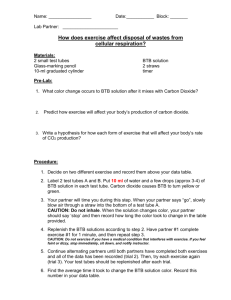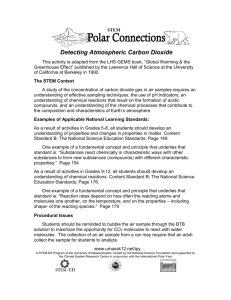Properties of Acids and Bases
advertisement

III. Properties of Acids and Bases Directions: Start on a fresh side/piece of a paper. Record the date and title of this activity. Your log should be neat, accurate, and complete. Be sure to number your answers and leave one or more lines between each answer. In the previous two activities you have been investigating and grouping several compounds based on their behavior with bromothymol blue (BTB). Today you will learn more about these “groups” of compounds. Get with your partner(s) and open your book to page 226. Take turns reading the paragraphs through page 229. As you read, discuss with your partner the various compounds you investigated in the previous two activities and how you would classify them based on what you are reading. In your log, answer the following questions in complete sentences (reword the question in the answer). 1. What does the book say “the system of classifying compounds into their families (acid, base, or neutral) is based on? 2. Discuss several ways in which acids are important in our lives (from the paragraphs AND the captions of the pictures). 3. Discuss several ways in which bases are important in our lives (from the reading AND the captions of the pictures). 4. What is the definition of an indicator? Give the name of two indicators mentioned in the book. Name one from lab. 5. Make a T-chart, title one side “Acids”. Make a bulleted list of specific properties (not the examples) found in the first 4 paragraphs. Along with the other properties, be sure to include the names and results of the two indicators mentioned and the ion produced by acids. These are key. (You will complete the other side of the T-chart later.) 6. Study the list of common acids. In what way are the chemical formulas of acids similar (compared to SrCl2 or NaOH?) 7. Discuss two acids you find on the list of common acids that you use regularly, include how they are used. 8. Name three strong acids and discuss what they produce that makes them strong acids? 9. Title the other side of the T-chart you created in question 4, “Bases”. Make a bulleted list of specific properties (not the examples) found in the 3 paragraphs. Along with the other properties, be sure to include the names and results of the two indicators mentioned and the ion produced by bases. These are key. 10. Discuss two bases from the list of common bases that you have likely used recently, include how they were used. 11. Based on your reading, what do scientists call substances that behave like BTB? Using what you have read, explain when BTB changes color (similar to the way your book describes Litmus paper). Copy the data chart below into your science log. In the “substance” column, record vinegar, ammonia, and then list the 7 substances you worked with yesterday. Based on the properties of each substance and data you gathered using BTB, predict whether you think each is an “acid”, “base” or “neither” and record in the prediction column. Title the data chart. Substance Prediction Blue Litmus Red Litmus Phenolphthalein (PHTH) Results If you have time, complete yesterday’s lab. You should already have the data chart prepared and predictions made. 12. Follow the procedure you used in previous labs to determine what happens to each of the substances when mixed with vinegar (using each of the colored liquids in place of BTB). Repeat to determine what happens to each substance when mixed with ammonia. Record both quantitative and qualitative observations for each. One of the properties of BTB is that it can be turned back to its original color. Test this property for any substance(s) that behaved like BTB. 13. Review your data. List any substance(s) that behaved like BTB. Clearly describe in what way it behaves like BTB.











